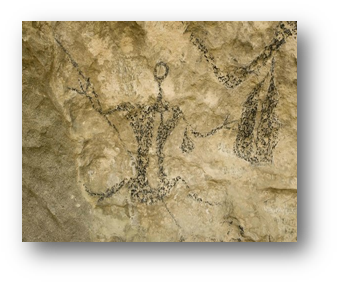Down the Valley - Maori Rock Art
Rock drawings are one of the oldest forms of art. We are lucky in the Waitaki Valley to have many examples of New Zealand’s own version of this art.
The pale, fine textured limestone provided an ideal surface to draw on. The artists used the closest material to hand, charcoal (a burnt stick from their fires). The red drawings are made from Kokowai (red oxide of iron) mixed with bird or fish oil. Where there is no limestone the drawings were made on the smooth surface of grey-wacke rock.
The Southern Maori have long believed that anything painted red keeps away the evil spirits or the attentions of the Maeroera (wild men of the bush).
The marvel of these drawings is that they are easily perishable but have lasted so long exposed to all types of weather. Carbon dating shows most were drawn between 1100AD and 1500AD.
Takiroa Rock Art Shelter (c.1400-1900)
No one knows who first daubed charcoal and red ochre on these walls. The images range from abstract forms, to bird, animal life and people. The presence of bones from moa and the extinct quail suggest that they started early. There may have been a long break in continuity, because 19th-century Ngāi Tahu said that they did not know who had put the work there. Depictions of European sailing ships and animals, however, suggest that someone revived the tradition. Takiroa is a remarkable record of a vanished world. The conservation plan states, ‘regardless of the precise dates of this chain of events, … the landscape in which Takiroa stands, and which was familiar to the people who created this artwork, may have undergone major change a few hundred years ago. Massive deforestation caused by fires, probably mainly human-induced, ravaged the South Island East Coast and produced the familiar landscape we erroneously think timeless.’
People and livestock have also ravaged places such as Takiroa. It lost some drawings during the First World War when J.L. Elmore extracted them for museums. The fences that went up in 1930 and again in 1964 deterred neither people nor stock. In the 1990s the former Historic Places Trust re-fenced and interpreted the site, by then an historic reserve. There are two ‘galleries’, with the older material in the larger one to the left, post-contact era drawings in the overhang to the right.
Maerewhenua Historic Area
The Maerewhenua Historic Area is one of the most well known sites with extant Maori rock art in Aotearoa New Zealand, One of only two such sites in the South Island open to the public. The historic area includes both pre and post-European occupation sites. The painted rock art is within a limestone shelter. Some is believed to pre-date European contact. The region that this historic area is located within has many early traditional stories associated with it. The area is of highest cultural and spiritual significance to the Ngai Tahu Whanui.This historic place (Rock Shelter, Record Number 5662) is the main caged rock art site within the Maerewhenua Historic Area. The historic place consists of a deep, partly stone-floored shelter. The surface has been decorated with many drawings. The landscaping and developments that have occurred in this area have been primarily to provide access to this caged shelter. The most visible and accessible rock art in this historic area. This historic place is located on private land, but a path to the rock art site has been made accessible to public for the purpose of viewing this historic place.
To get there:
For the Takiroa Maori Rock Art site travel towards Oamaru from Kurow on Kurow– Duntroon Road (State Highway 83) for approximately 20km. The site is to your right on this road and is signposted.
For the Maerewhenua site travel towards Oamaru from Kurow on Kurow– Duntroon Road (State Highway 83) , at the Maerewhenua Bridge at the eastern end of Duntroon turn right onto Dansey’s Pass Road. The art is about 500m on your left at the Settlement Road intersection.


